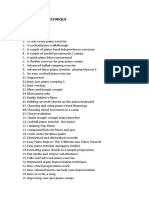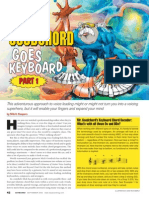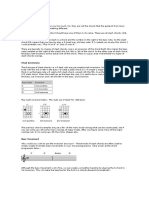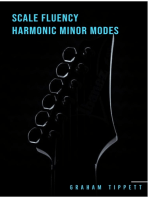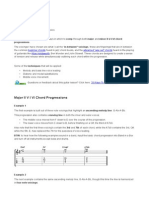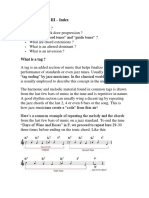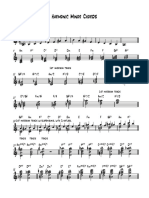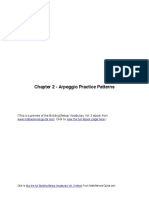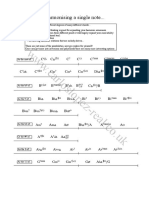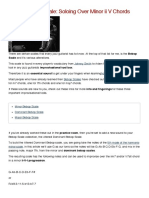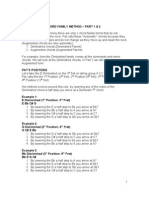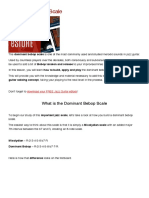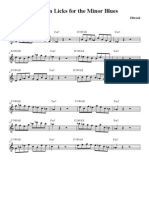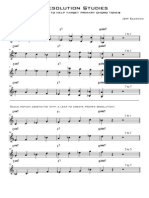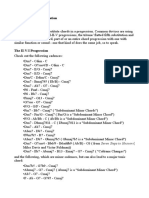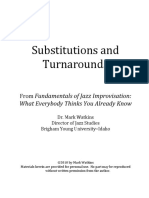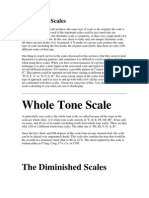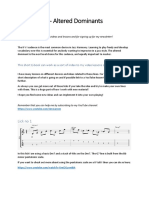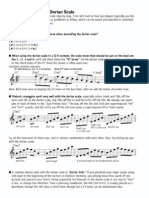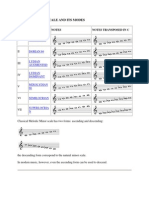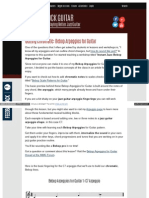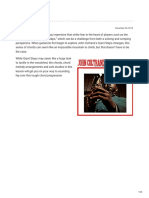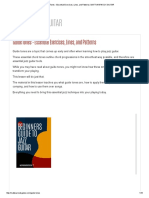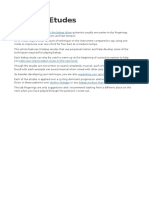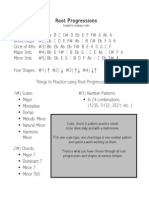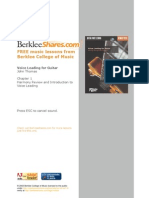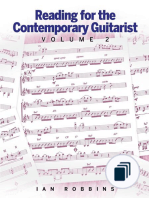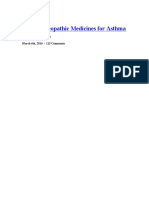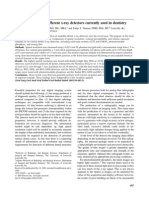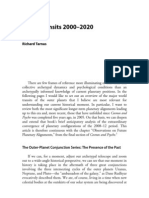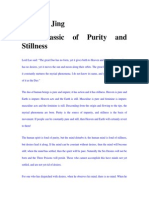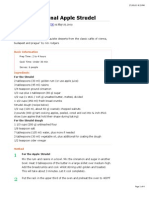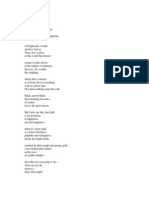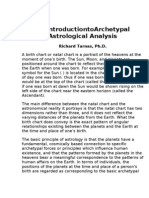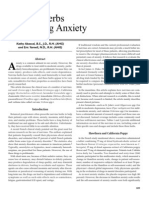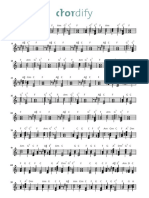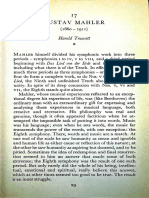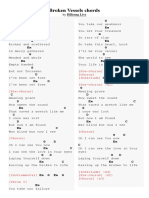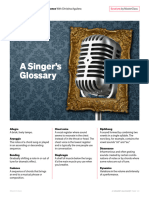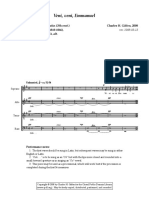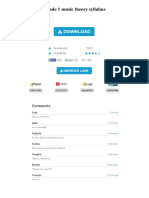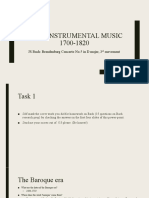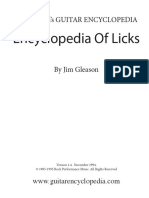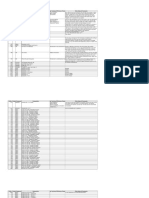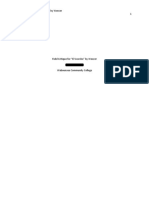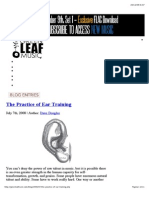Altered Dominants
Altered Dominants
Uploaded by
pnogrlCopyright:
Available Formats
Altered Dominants
Altered Dominants
Uploaded by
pnogrlCopyright
Available Formats
Share this document
Did you find this document useful?
Is this content inappropriate?
Copyright:
Available Formats
Altered Dominants
Altered Dominants
Uploaded by
pnogrlCopyright:
Available Formats
Altered Dominants: The Polytonal Approach
The dominant chord is possibly the most important chord in Western music, because of its need to resolve to tonic harmony. Of course, this principal extends into the realm of jazz music as well. However, in jazz, dominant chords are often presented with significant alteration. There are many different ways to alter a dominant chord in jazz. More often than not, the complex chord symbol that results can be confusing. What follows is a discussion of some of the most common altered dominant chords and their corresponding scales, as well as a different way of thinking of these chords. It is crucial to both play these chords on the piano and spend a good deal of time practicing the melodic sounds that match the harmonies.
Diminished Harmony
The dominant 7th chord with a flatted ninth degree typically suggests diminished harmony, because when the root is removed from the chord, the remaining chord tones (3, 5, 7, b9) form a fully diminished 7th chord. If this chord is extended to the 13th, we notice that the 13, b9, and 3 of the chord in the first example below form an A major triad that rests atop a C7 chord. The dominant 7th chord with both a flatted 9th and raised 11th is also suggestive of diminished harmony, and results in another polychord combining C7 and an F# major triad.
The #11 Chord
Another common altered dominant chord is one that has a raised 11th. This chord has a variety of uses, and frequently helps to resolve dominant chords in unusual and unexpected ways. For example, the second chord of A Girl From Ipanema (G7(#11)) resolves to Gmin7. In Stella By Starlight, we find an Ab7(#11) resolving upward to a BbMaj7 chord. These types of resolutions are common in a manytunes, and this chord is something all students of jazz should learn well. It is also possible to look at this chord in a polychordal manner. Extending the chord to the 13th, we find that the 9, #11, and 13 form a major triad. The example below shows a C13(#11) chord as nothing more than a D major triad atop a C7 chord.
The ALT Chord (aka the #9 #5 chord)
Perhaps the most mislabeled chord in jazz is the ALT chord, typically written as C7ALT. These three letters create more confusion than any other chord, and many players have differing opinions on what this chord really means. A way of looking at this chord is as a C7 (#9#5) chord, as seen below. Once again, this is a very commonly used chord, particularly over the dominant chord in a ii-V-I progression. It suggests a tritone substitution without replacing the root in the progression. Again, a polychordal way of viewing this chord would be to combine an Ab major triad and C7 chord, as seen below.
Scales for Altered Dominants
Because each of these altered chords suggests a certain unique harmony, each demands a different scale to be used for each chord. Diminished Harmony Chords that suggest diminished harmony also suggest the use of the diminished scale. There are almost limitless numbers of things you can do with a diminished scale, a topic for another discussion. For now, lets investigate why this scale sounds so good over C7(b9) and C7(b9#11). In the example below, we see a C7(b9) chord with a diminished scale written above it. Analyzing the notes of the scale and how they function over the given chord, we find the following relationships: Note C Db Eb E F# G A Bb Function 1 (root) b9 #9 3rd #11 (or b5) 5th 13th 7th
The result is that we have all of the important chord tones (including the alteration(s)) and some additional color tones. It is worth noting that another option for the b9 chord is to utilize the harmonic minor scale of the key the chord should resolve to. For example, when playing over a C7(b9) chord, one could use the F harmonic minor scale, as many Bebop players did.
#11 Chords
Turning our attention to #11 chords, we encounter a new scale, also known as the Lydian dominant scale. While this name can be scary at first, it is nothing more than a mode of the ascending melodic minor scale (which, in and of itself, is only one note different from a major scale). Lets look at the function of the notes of this scale: Note C D E F# G A Bb Function 1 (root) 9 3rd #11 5th 13th 7th
Once again, we find that this scale contains only chord tones if we include the 13th in our discussion. This is a very useful scale for a very useful chord.
ALT Chords
Finally, we arrive at the chord/scale relationship for ALT chords. We turn again to a mode of the melodic minor (this time the 7th mode of melodic minor). This chord has been referred to as the diminished-whole tone scale or superlocrian scale. Call it what you likeit works and sounds great! Heres how this scale works: Note C Db Eb E F# Ab/G# Bb Function 1 (root) b9 #9 3rd #11 (or b5) #5 (or b13) 7th
Here we have the most important chord tones (1, 3, 7) joined by four very beautiful color tones. Mastery of these chords and scales will help you develop the modern melodic and harmonic vocabulary of todays leading players. There are a myriad of additional resources that cover all of these concepts in further detail, and they should be readily available.
You might also like
- INTRO TO PIANO TECHNIQUE by BILL HILTON PDFDocument3 pagesINTRO TO PIANO TECHNIQUE by BILL HILTON PDFCamyla CostaNo ratings yet
- World of Warcraft - Fall of The Lich King - InvincibleDocument5 pagesWorld of Warcraft - Fall of The Lich King - InvincibleAdrian Meki Sanchis SarrioNo ratings yet
- Viola Concerto in C MinorDocument8 pagesViola Concerto in C MinorMichael Jefferson T. Valdez0% (1)
- 6 Essential Giant Steps Patterns For Jazz Guitar - MATT WARNOCK GUITARDocument11 pages6 Essential Giant Steps Patterns For Jazz Guitar - MATT WARNOCK GUITARPedroMiranda100% (3)
- Mr. GoodchordDocument13 pagesMr. Goodchordfounagerthegreat100% (4)
- Neo-Soul: Example 3 (E7 ( 9) ) Fdim7/eDocument5 pagesNeo-Soul: Example 3 (E7 ( 9) ) Fdim7/eraphaelcorteziNo ratings yet
- Being Human: The Nature of Spiritual ExperienceDocument4 pagesBeing Human: The Nature of Spiritual ExperiencepnogrlNo ratings yet
- Icz Worship AcordesDocument21 pagesIcz Worship AcordesKeivin Medina75% (4)
- Ruwet - Methods of Analysis in MusicologyDocument34 pagesRuwet - Methods of Analysis in MusicologyAnonymous Z4yz4JWKqF100% (1)
- Half-Whole Diminished ExplanationsDocument4 pagesHalf-Whole Diminished Explanationsjaydub911100% (3)
- Altered Dominant HarmonyDocument3 pagesAltered Dominant HarmonyBartolotti100% (4)
- Slash ChordsDocument11 pagesSlash Chordshsl2013100% (1)
- Augmented Scale Theory - Javier ArauDocument23 pagesAugmented Scale Theory - Javier ArauAl Crowley100% (8)
- 20 Ways To Comp II V I VI Chord ProgressionsDocument9 pages20 Ways To Comp II V I VI Chord ProgressionsUr Ra100% (1)
- Turnarounds: How To Turn One Chord Into Four: Home Jazz Guitar Store The Blog Guitar Forum Free BookDocument7 pagesTurnarounds: How To Turn One Chord Into Four: Home Jazz Guitar Store The Blog Guitar Forum Free Bookcabralbruno10100% (1)
- Jazz Chords Part IIIDocument8 pagesJazz Chords Part IIIPame Araujo RocknrollNo ratings yet
- Andy Laverne - How To Create Your Own Substitute Chords and ReharmonizationsDocument3 pagesAndy Laverne - How To Create Your Own Substitute Chords and ReharmonizationsLilica CherokeeNo ratings yet
- Reharmonization 101Document5 pagesReharmonization 101Godwin Ariwodo100% (2)
- Harmonic Minor ChordsDocument3 pagesHarmonic Minor ChordsRoy Verges67% (3)
- Chord Scale Summation (Not All Possibilities But Most Common) Diatonic Scale TensionsDocument2 pagesChord Scale Summation (Not All Possibilities But Most Common) Diatonic Scale TensionsEduardo Diez Vieira100% (3)
- ClusterDocument2 pagesClusterRodolfo Amaral de AlmeidaNo ratings yet
- Harmonic TheoryDocument50 pagesHarmonic TheoryDaddyb71100% (1)
- Building Bebop Vocabulary Vol. 2 Preview PDFDocument10 pagesBuilding Bebop Vocabulary Vol. 2 Preview PDFAloysius Julindra100% (2)
- Building Blocks 2-5'sDocument8 pagesBuilding Blocks 2-5'sJeff EllwoodNo ratings yet
- Harmonising A Single NoteDocument2 pagesHarmonising A Single Noteclopez_real100% (3)
- Triad Spread VoicingsDocument2 pagesTriad Spread Voicingsdrewdrew525100% (1)
- Altered Bebop Scale - Soloing Over Minor II V ChordsDocument5 pagesAltered Bebop Scale - Soloing Over Minor II V ChordsPedroMiranda100% (2)
- Pentatonic SubsDocument4 pagesPentatonic SubsJazzGuy100% (2)
- Lydian-Dominant Theory For ImprovisationDocument19 pagesLydian-Dominant Theory For ImprovisationEric Marquis100% (2)
- Dan Haerle QuartalDocument12 pagesDan Haerle QuartalAlexandre VicenteNo ratings yet
- Martino Chord FamilyDocument9 pagesMartino Chord FamilySrđan Sarkanjac100% (1)
- Rhythm Changes The Ultimate GuideDocument60 pagesRhythm Changes The Ultimate GuideToroPolaco100% (4)
- Bebop ScaleDocument4 pagesBebop ScaleIván Ivan100% (1)
- Harmonizing Jazz Melodies Using Clusters: Ex. 1: C Major Scale Harmonized in ClustersDocument5 pagesHarmonizing Jazz Melodies Using Clusters: Ex. 1: C Major Scale Harmonized in ClustersChip Smith100% (2)
- SCALES For JAZZ IMPROVISATIONDocument4 pagesSCALES For JAZZ IMPROVISATIONAntonio100% (1)
- Dominant Bebop ScaleDocument10 pagesDominant Bebop ScalePedroMiranda100% (1)
- Alt Dominant IdeasDocument2 pagesAlt Dominant IdeasJeff Ellwood100% (8)
- ResolutionsDocument2 pagesResolutionsJeff Ellwood100% (2)
- ReharmDocument3 pagesReharmLorenzo Nomenclatore Tomelleri100% (2)
- 13 Substitutions and TurnaroundsDocument15 pages13 Substitutions and Turnaroundsjimurga100% (3)
- Wholetone DiminishedDocument2 pagesWholetone Diminishedkmdsax100% (1)
- Jazz Piano Voicings Mnemonics JB Dyas PHD Revised 2020.Document8 pagesJazz Piano Voicings Mnemonics JB Dyas PHD Revised 2020.DMNo ratings yet
- Bebop Scales PDFDocument53 pagesBebop Scales PDFAnonymous tIYTpTk7b100% (1)
- Diminished PatternsDocument1 pageDiminished Patternsmisozachar3731100% (1)
- 5 Approaches To Soloing Over The Bridge To Rythm ChangesDocument11 pages5 Approaches To Soloing Over The Bridge To Rythm Changesvetah.ndaw1974100% (3)
- Complete Guide To Jazz Scales and Modes - Matt WarnockDocument151 pagesComplete Guide To Jazz Scales and Modes - Matt WarnockDavid Savage100% (2)
- 15 II V I Licks Altered DominantsDocument8 pages15 II V I Licks Altered DominantsTamaNo ratings yet
- Speaking Jazz Creating LinesDocument2 pagesSpeaking Jazz Creating LinesRob Oxoby80% (5)
- Dominant 7 SubstitutionsDocument4 pagesDominant 7 SubstitutionsBartolotti100% (1)
- Harmonic Minor ModesDocument6 pagesHarmonic Minor ModesJorge Lopez100% (1)
- Symmetrical Harmonies... The Tritone ProgressionDocument40 pagesSymmetrical Harmonies... The Tritone Progressionelasticman16100% (21)
- Bebop ArpeggiosDocument16 pagesBebop ArpeggiosJohnny Dema67% (15)
- Augmented Scale Theory at Ja..Document22 pagesAugmented Scale Theory at Ja..Kraljević Mirko100% (1)
- Jazzguitar - Be Giant StepsDocument23 pagesJazzguitar - Be Giant StepsRudy Kolder100% (1)
- Coltrane Substituttion ChangesDocument2 pagesColtrane Substituttion Changesroccotullo100% (2)
- Guide Tones - Essential Exercises, Lines, and Patterns - MATT WARNOCK GUITARDocument16 pagesGuide Tones - Essential Exercises, Lines, and Patterns - MATT WARNOCK GUITARLouis Migliore75% (4)
- The 50s Cliche - Part 2 Relations Between ChordsDocument5 pagesThe 50s Cliche - Part 2 Relations Between ChordsLeo Fernández100% (1)
- Rhythm Change LinesDocument3 pagesRhythm Change LinesFelix De Braeckeleer83% (6)
- Bebop Etudes PDFDocument8 pagesBebop Etudes PDFchristian_l_martins100% (3)
- Octave DivisionDocument1 pageOctave DivisionJeff Ellwood100% (1)
- Guide TonesDocument3 pagesGuide TonesMichael VochezerNo ratings yet
- Hal Galper Book PDFDocument1 pageHal Galper Book PDFfabz7775% (4)
- Breklee - Voice LeadingDocument12 pagesBreklee - Voice LeadingFractus AnomaliiNo ratings yet
- Green Onions GDocument2 pagesGreen Onions GpnogrlNo ratings yet
- The Lineage and Form of Moy Lin Shin: - Reinforcing Basic Principles of Our Tai ChiDocument4 pagesThe Lineage and Form of Moy Lin Shin: - Reinforcing Basic Principles of Our Tai ChipnogrlNo ratings yet
- Four Homeopathic Medicines For AsthmaDocument38 pagesFour Homeopathic Medicines For AsthmapnogrlNo ratings yet
- Strain Counterstrain Devine - ClinicalSCSSAAODocument88 pagesStrain Counterstrain Devine - ClinicalSCSSAAOpnogrlNo ratings yet
- Musical Theory and Ancient CosmologyDocument19 pagesMusical Theory and Ancient CosmologypnogrlNo ratings yet
- A Comparison of 18 Different X-Ray Detectors Currently UsedDocument5 pagesA Comparison of 18 Different X-Ray Detectors Currently UsedpnogrlNo ratings yet
- Tarnas World Transits 2000-2020 An OverviewDocument66 pagesTarnas World Transits 2000-2020 An Overviewleonrel100% (4)
- Qingjing Jing - The Classic of Purity and StillnessDocument3 pagesQingjing Jing - The Classic of Purity and StillnesspnogrlNo ratings yet
- Traditional Apple Strudel: ReferencesDocument4 pagesTraditional Apple Strudel: ReferencespnogrlNo ratings yet
- Poppies - Mary OliverDocument1 pagePoppies - Mary OliverpnogrlNo ratings yet
- Richard TarnasDocument31 pagesRichard Tarnaspnogrl100% (5)
- Nervine Herbs For Treating AnxietyDocument7 pagesNervine Herbs For Treating Anxietypnogrl100% (1)
- Dani Balea - Taragot - InstrumentalDocument2 pagesDani Balea - Taragot - InstrumentalEugen-Nicolae Butiu100% (1)
- The Symphony - Robert SimpsonDocument23 pagesThe Symphony - Robert SimpsonMiguelangel UrbanoLasarteNo ratings yet
- Broken VesselDocument1 pageBroken VesselTanya ValenciaNo ratings yet
- M 2 V 8 QXBPZNQMGQ 0 Omuwuyqhchig 3Document2 pagesM 2 V 8 QXBPZNQMGQ 0 Omuwuyqhchig 3andra.georgescuNo ratings yet
- Guitar ChordsDocument13 pagesGuitar ChordsAti MamoraNo ratings yet
- Devaney Intonation 10Document25 pagesDevaney Intonation 10JoeNo ratings yet
- Research Post 3 - Bass NuancesDocument4 pagesResearch Post 3 - Bass Nuancesvijaymusic88No ratings yet
- Concerto For Clarinet No.2, Op.57: Louis Spohr (1784-1859)Document18 pagesConcerto For Clarinet No.2, Op.57: Louis Spohr (1784-1859)Rúben FonsecaNo ratings yet
- Nose-Bleed Music TheoryDocument3 pagesNose-Bleed Music TheoryChris AndersonNo ratings yet
- Mahler Symphony 2 Low Brass ExcerptsDocument6 pagesMahler Symphony 2 Low Brass ExcerptsJavier Galindo CalvoNo ratings yet
- Intro To Chords-IntervalsDocument3 pagesIntro To Chords-IntervalsRaoulNo ratings yet
- Snarky Puppy - Ready Wednesday GuitarDocument2 pagesSnarky Puppy - Ready Wednesday GuitarBS PianoNo ratings yet
- Giffen-Veni, Veni EmmanuelDocument8 pagesGiffen-Veni, Veni EmmanuelRodvin BuadaNo ratings yet
- Grade 1 Music Theory SyllabusDocument3 pagesGrade 1 Music Theory SyllabusMichelle0% (2)
- My Bach Powerpoint 1Document10 pagesMy Bach Powerpoint 1squailgeNo ratings yet
- zzEncyclopediaOfLicks PDFDocument358 pageszzEncyclopediaOfLicks PDFxty115100% (4)
- Round (Music) - WikipediaDocument4 pagesRound (Music) - Wikipediahaykalham.piano9588No ratings yet
- DFGHJDocument1 pageDFGHJThanavit ThirachainanNo ratings yet
- Piano Repertoire by DifficultyDocument42 pagesPiano Repertoire by DifficultyAndrew Janes50% (2)
- El Scorcho EssayDocument10 pagesEl Scorcho EssayMitchel DuttonNo ratings yet
- The Practice of Ear TrainingDocument11 pagesThe Practice of Ear TrainingAndrea Lamacchia100% (3)
- (Free Scores - Com) Anonymous Ave Maria For Flutes Harp Flutes Part 58246Document2 pages(Free Scores - Com) Anonymous Ave Maria For Flutes Harp Flutes Part 58246Mariana GomesNo ratings yet
- Dio Che Nell'Alma - PDF Full Orchestra ScoreDocument2 pagesDio Che Nell'Alma - PDF Full Orchestra ScoreOscar AfanadorNo ratings yet
- And Hold in Memory Teachers Guide ADocument15 pagesAnd Hold in Memory Teachers Guide AIsaias JuniorNo ratings yet
- Composers Counterpoint - Charles W. Pearce PDFDocument144 pagesComposers Counterpoint - Charles W. Pearce PDFFelipe Silva100% (2)
